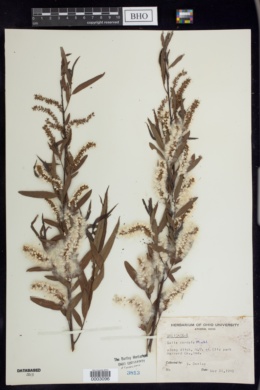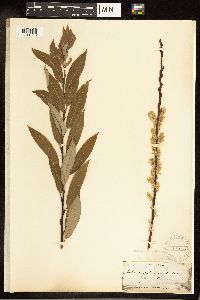Salix cordata
|
|
|
|
Family: Salicaceae
Heart-Leaf Willow, more...heartleaf willow
[Salix pseudocordata var. cordata (Andersson) C.K.Schneid.] |
Plants 0.4-3 m, (often forming clones by layering or stem fragmentation). Stems: branches (sometimes ± brittle at base), red-brown, not glaucous (slightly glossy), tomentose to glabrescent; branchlets red-brown, moderately to very densely villous. Leaves: stipules foliaceous, apex acute or rounded; petiole shallowly grooved adaxially, 1-13 mm, tomentose adaxially; largest medial blade narrowly oblong, or narrowly to broadly elliptic, 33-88 × 13-45 mm, 1.6-3.2 times as long as wide, base cordate, rounded, or convex, margins flat or slightly revolute, serrulate or spinulose-serrulate, apex acuminate, abaxial surface not glaucous, moderately densely villous to glabrescent, midrib remaining hairy, hairs straight or wavy, adaxial dull or slightly glossy, very densely villous to glabrescent, midrib remaining hairy; proximal blade margins entire or serrulate; juvenile blade yellowish green, abaxially villous or midrib long-silky, hairs white. Catkins flowering as leaves emerge; staminate stout, 17-40 × 8-15 mm, flowering branchlet 1-8 mm; pistillate moderately densely flowered, stout or slender, 27-65 × 8-19 mm, flowering branchlet 3-16 mm; floral bract brown, 1-2.6 mm, apex acute or rounded, abaxially hairy, hairs straight or wavy. Staminate flowers: adaxial nectary oblong or narrowly oblong, 0.3-1.3 mm; filaments distinct, glabrous; anthers yellow, (ellipsoid or shortly cylindrical), 0.6-0.8 mm. Pistillate flowers: adaxial nectary oblong or narrowly oblong, 0.4-1.3 mm, about same length as stipe; stipe 0.5-1.4 mm; ovary pyriform or obclavate, glabrous, beak slightly bulged below styles; ovules 11-24 per ovary; styles 0.7-1.6 mm; stigmas flat, abaxially non-papillate with rounded tip, or 2 plump lobes, 0.2-0.3-0.36 mm. Capsules 3.6-7 mm. 2n = 38. Flowering mid Apr-early Jul. Sand dunes and beaches; 0-200 m; Nfld. and Labr., Ont., Que.; Ill., Ind., Mich., N.Y., Pa., Wis. Salix cordata seems to be rare in Labrador, Newfoundland, and Quebec; the species needs further study in those areas.
Shrub 2 - 4 m tall Leaves: alternate, on 3 - 6 mm long, basally flattened leafstalks, green on both sides, 3 - 10 cm long, broadly egg-shaped to broadly lance-shaped with a rounded to heart-shaped base and short-pointed tip, gland-toothed, and densely silky-hairy on both sides. Flowers: either male or female, borne on separate trees (dioecious) in cylindrical catkins. The catkin is hairy and grows on a short, leafy stalk. Female catkin greenish with light brown scales, 3 - 10 cm long. Ovary hairless. Male catkin about 2 cm long with light brown scales. Anthers yellow. Fruit: a capsule, in elongated clusters, brown, 4 - 10 cm long, and flask-shaped. Seeds have long, white, silky hairs attached. Twigs: thick, gray to reddish brown, densely silky-hairy. Buds: brown to reddish brown, egg-shaped, round-tipped to pointed, often flattened against the stem. Similar species: In the Chicago Region, Salix cordata differs from all other shrub willows by having green, densely silky-hairy, and finely toothed leaves that are not revolute (rolled downward along the margins). Flowering: late April to early May, before or with the leaves Habitat and ecology: Rare. In the Chicago Region, Salix cordata is found in the low dunes facing Lake Michigan. It also occurs on the higher foredunes. Occurence in the Chicago region: native Notes: The overall whitish appearance of Salix cordata contrasts observably with any darker leaved willows in its vicinity. Only female shrubs are used in cultivation. Etymology: Salix is the Latin word for willow. Cordata means heart-shaped, which refers to the heart-shaped leaf bases. Author: The Morton Arboretum Shrub (1-)2-3 m, the vegetative parts all ±pubescent, the young twigs densely gray-tomentose; stipules cordate-ovate or subreniform, 6-15 mm; petioles 4-8 mm, somewhat clasping; lvs lance-ovate to broadly ovate, 4-6(-8) נ1.5-3(-4) cm, abruptly acuminate, glandular-serrate, rounded or cordate at base, green on both sides, ±lanate, strongly nerved beneath; catkins with the lvs, 5-8 cm, on 3-5-lvd peduncles 1-2.5 cm; scales brown, densely long-villous; stamens 2; frs lanceolate, 5-8 mm, glabrous; pedicels 0.5-1 mm; style 0.7-1.5 mm; 2n=44. Sandy and alluvial shores, or often on dunes; Nf. and e. Que. to N.S., n. Me., and w. around the Great Lakes to Ill., Wis., and n. Mich., n. to Hudson Bay. (S. adenophylla; S. syrticola) Plants with the twigs, petioles and blades (except the midrib) ±glabrate or glabrous have been called var. abrasa Fernald. Gleason, Henry A. & Cronquist, Arthur J. 1991. Manual of vascular plants of northeastern United States and adjacent Canada. lxxv + 910 pp. ©The New York Botanical Garden. All rights reserved. Used by permission. From Flora of Indiana (1940) by Charles C. Deam This willow is infrequent throughout the lake area, becoming progressively less frequent southward and probably entirely absent from the southwestern part. It prefers a moist soil but does not demand a very wet soil such as is found in bogs and marshes. Salix cordata var. angustata Anders. is a narrowleaf form which I have from Wabash County. The species freely hybridizes and I have several specimens of each of two of its hybrids, S. cordata X nigra and S. cordata X sericea. [Deam also recognizes S. adenophylla which has leaves green on both sides (rather than paler beneath) and more dense silky-pubescence on the upper surface. This plant was] formerly more or less frequent along Lake Michigan at the base of the first dune on the side facing the beach. It is now nearly extinct on account of the encroachments of civilization and the attacks of the oyster-shell scale. …… Indiana Coefficient of Conservatism: C = 10 Wetland Indicator Status: FAC |



































































































